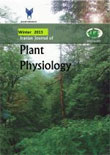فهرست مطالب

Iranian Journal of Plant Physiology
Volume:2 Issue: 3, Spring 2012
- تاریخ انتشار: 1390/07/28
- تعداد عناوین: 9
-
-
Pages 435-443The effect of cadmium chloride concentrations (25.50, 75, and 100 mg/kg soil), seeds pre‐irradiated by low doses of gamma rays (15, 30, 45, and 60 Gy), potassium chloride (60 mg/kg soil) and the combination of cadmium gamma and cadmium potassium on Brassica rapa germination, oxidative stress and antioxidant system were investigated under laboratory and greenhouse conditions. Germination percentage decreased progressively by increasing cadmium chloride concentrations. Gamma irradiation and potassium treatment enhanced the germination and reduced cadmium toxicity when combined with it. All of the treatments relatively caused overproduction of H2O2. Peroxidase and catalase activities were increased by the cadmium concentrations while ascorbic acid was decreased.Keywords: Brassica rapa, cadmium chloride, gamma doses, potassium, germination, H2O2, catalase, peroxides, ascorbic acid
-
Pages 445-453In order to study the impact of drought stress and planting date on safflower yield andyieldcomponents, an experiment was performed in Tabriz region in 2011. The experiment was carried out assplit‐split plot based on randomized complete block design. The main factor which wasapplied as split plot includes drought stress with three levels: (S1) 80 ± 3 mm evaporation from basin level of class A, (S2) 120 ± 3 mm evaporation from basin level of class A, (S3) 160 ± 3 mm evaporation from basin level of class A. The subsidiary factor studied in this research was studying 2 levels of planting date including ( 1): conventional planting date in region (date: 2011/4/19) and (D2): 20days later from conventional planting date in region (Date: 2011/5/9). The sub‐subsidiary factor was two different safflower cultivars include (V1): Isfahan local cultivar and (V2): Goldasht as modified cultivar. According to results the impact of drought stress on plant dry weight and leaf dry weight, plant height, number of branches and sub‐shrubs, capitul in plant and seed in capitul as well as seed yield was significant. The effect of planting date on the traits being studied in this research was significant. The interaction of drought stress and planting date, except in dry weight of leaf, was not significant in other traits.Keywords: drought stress, planting date, safflower, yield
-
Pages 461-469The epiphytic lichen Flavoparmelia caperata were collected randomly from mountain forest sites of Firouzja (north of Iran) at 780m altitude, 36° 05' N latitude and 52° 40' E longitude. Also Physcia dubia was collected randomly from forest sites of Daronkola (north of Iran) at 22 m altitude, 36° 21' N latitude and 52° 43'E longitude. The study was aimed at recording the effects of seasonal changes on antioxidant enzymes activities and flavonoid, anthocyanin and phenolic compounds the two lichen species. The results showed that peroxidase activity in both species increased significantly in winter. The activity of polyphenol oxidase and ascorbate peroxidase in both species and catalase in P. dubia were increased in summer. In spring, polyphenol oxidase activity increased significantly more than in winter in Physcia dubia. Phenolic compounds in Flavoparmelia caperata increased significantly in winter compared to spring and summer, but in Physcia dubia they increased significantly in summer compared to winter and spring. Flavonoid and Anthocyanin compounds in Flavoparmelia caperata increased significantly in winter compared to spring and summer. In Physcia dubia, Flavonoid decreased significantly in spring compared to winter and summer, and anthocyanin increased significantly in winter compared to spring and summer. The results revealed that seasonal acclimation depended on the changes in antioxidants enzymes activity, flavonoid, anthocyanin and phenolic compounds in lichens.Keywords: antioxidant enzymes, flavonoid, anthocyanin, Phenolic compounds, Flavoparmelia caperata, Physcia dubia, Seasonal changes
-
Pages 471-475Studies show that Oryza sativa L. contains a structure named β‐glucan with anti cancer properties. In the present study, a tissue culture for rice was carried out and β‐glucan content was measured under various sugar and vitamin levels in basic MS medium. Seeds of Hashemi cultivar were cultured on MS medium. Two plant hormones, namely, 2,4‐D (0, 1, 1.5, 2 and 3 mg/l) and kinetin (0, 0.5, 1, and 1.5 mg/l) were used to form callus after one week. To extract β‐glucan, calluses were incubated by three different sugar treatments with concentrations 15, 30, and 45 g/l and by three vitamin treatments with concentrations 2/5, 5, and 10 cc. After 30 days, those calluses treated with sucrose 45 g/l had a deeper yellow color than other calluses. In fact, higher concentrations of sugar led to deeper color of calluses which were more rigid and dry and, at the same time, more fragile and less bright in color. The calluses were then dried in an oven, and soluble and insoluble sugars were extracted. Results indicated that highest levels of soluble and insoluble sugars (including β‐glucan) were achieved in medium containing 3% sucrose. Increase in vitamins did not generally affect soluble and insoluble sugars levels, and just in the medium containing 5cc vitamin, insoluble sugars increased.Keywords: Rice (Hashemi cultivar), callus, ??glucan, sucrose, vitamin, soluble sugar, insoluble sugar (?? glucan)
-
Investigating the most effective compounds in medicinal plant of Sambucus nigra in Azarbayjan regionPages 485-488
For many years now, identification of native medicinal plants which are effective in improving human health has been the focus of attention by the United Nations World Health Organization. Sambucus nigra is a valuable medicinal plant used for a long time in traditional medicine for prevention and treatment of common diseases such as cold, joint swell, and rheumatic pains. In this research, root, stem and leaf samples of Sambucus nigra were collected at altitude of 850 m from Souly valley in Azerbaijan region in northwestern Iran and the plant extracts were obtained from dry samples powder. Various compounds were identified by gas chromatography apparatus. The most important compounds included quercetin (11.3%), sambunigrin (7.6%), astragalin (5.7%), isoquerctin (4.8%), delphinidin, 3 rutinoside(6.1%), cyaniding ‐3, and 5 diglucoside (4.1%). The study also revealed that the amount of these compounds in leaves was generally more than in the other parts of the plant.
Keywords: extract, Sambucus nigra, effective compounds, gas chromatography -
Page 489

